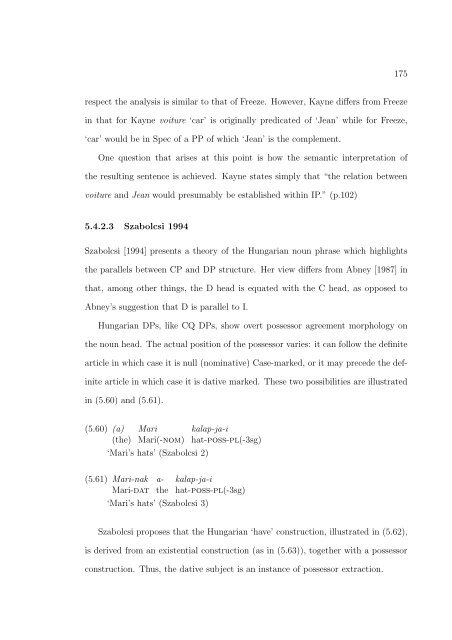the syntax and semantics of relativization and quantification
the syntax and semantics of relativization and quantification
the syntax and semantics of relativization and quantification
You also want an ePaper? Increase the reach of your titles
YUMPU automatically turns print PDFs into web optimized ePapers that Google loves.
175<br />
respect <strong>the</strong> analysis is similar to that <strong>of</strong> Freeze. However, Kayne differs from Freeze<br />
in that for Kayne voiture ‘car’ is originally predicated <strong>of</strong> ‘Jean’ while for Freeze,<br />
‘car’ would be in Spec <strong>of</strong> a PP <strong>of</strong> which ‘Jean’ is <strong>the</strong> complement.<br />
One question that arises at this point is how <strong>the</strong> semantic interpretation <strong>of</strong><br />
<strong>the</strong> resulting sentence is achieved. Kayne states simply that “<strong>the</strong> relation between<br />
voiture <strong>and</strong> Jean would presumably be established within IP.” (p.102)<br />
5.4.2.3 Szabolcsi 1994<br />
Szabolcsi [1994] presents a <strong>the</strong>ory <strong>of</strong> <strong>the</strong> Hungarian noun phrase which highlights<br />
<strong>the</strong> parallels between CP <strong>and</strong> DP structure. Her view differs from Abney [1987] in<br />
that, among o<strong>the</strong>r things, <strong>the</strong> D head is equated with <strong>the</strong> C head, as opposed to<br />
Abney’s suggestion that D is parallel to I.<br />
Hungarian DPs, like CQ DPs, show overt possessor agreement morphology on<br />
<strong>the</strong> noun head. The actual position <strong>of</strong> <strong>the</strong> possessor varies: it can follow <strong>the</strong> definite<br />
article in which case it is null (nominative) Case-marked, or it may precede <strong>the</strong> definite<br />
article in which case it is dative marked. These two possibilities are illustrated<br />
in (5.60) <strong>and</strong> (5.61).<br />
(5.60) (a)<br />
(<strong>the</strong>)<br />
Mari<br />
Mari(-nom)<br />
‘Mari’s hats’ (Szabolcsi 2)<br />
kalap-ja-i<br />
hat-poss-pl(-3sg)<br />
(5.61) Mari-nak<br />
Mari-dat<br />
a-<br />
<strong>the</strong><br />
‘Mari’s hats’ (Szabolcsi 3)<br />
kalap-ja-i<br />
hat-poss-pl(-3sg)<br />
Szabolcsi proposes that <strong>the</strong> Hungarian ‘have’ construction, illustrated in (5.62),<br />
is derived from an existential construction (as in (5.63)), toge<strong>the</strong>r with a possessor<br />
construction. Thus, <strong>the</strong> dative subject is an instance <strong>of</strong> possessor extraction.
















